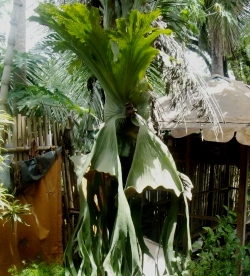The Giant Staghorn Fern or Capa de Leon (Platycerium grande) is one of the most interesting members of the hanging ferns.
It is a highly prized ornamental crop due to its majestic form and size.
This fern belongs to the phylum Pteridophyta (ferns and allies) under the order Polypodiales and family Polypodiaceae and is endemic in the Philippines.
Davao is particularly popular as a place where live specimens of this fern can be easily found.

The Giant Staghorn Fern is an epiphytic fern and grows alone or in clusters by clasping the trunks or branches of trees.
The plant has two types of leaves or fronds: base fronds and foliar fronds.
The base fronds or sterile fronds are those which grow upward and sideward and are responsible for the attachment of the plant to the tree or any support.
The portion between the basal fronds and the trunk of the tree often forms a nest-like depression into which leaf litter accumulates.
The foliar fronds or fertile fronds are those which produce the reproductive organ of ferns called spore.
These fronds fork downward and look like the antler of a stag (deer) with its base on top.
It can grow up to 5 feet long (Steiner 1986).
The spores are contained in the sporangium which together form the sorus (pl. sori) (Cullina 2008).
The semicircular soral patches are found on the undersurfaces of the foliar fronds and are colored brownish when mature.
However, due to excessive harvesting and because the spores are difficult to propagate under normal conditions, it has become endangered (Amoroso 1990; Amoroso and Amoroso 2003).
Concerned about the threat of extinction, Dr. Victor B. Amoroso and wife Cecilia B.
Amoroso developed the spore culture technology through tissue culture for the propagation and conservation of the Giant staghorn and other endangered fern species (su.edu.ph 2012).
But click here to read how we propagated the Giant Staghorn (capa de leon) in the backyard using sustainable methods.
REFERENCES
AMOROSO CB. 1990. Gametophyte morphology of Platycerium grande (Fee) Presl. (abs.). CMU Journal of Science. Jul-Dec. 1990. Retrieved July 12, 2012, from http://agris.fao.org/agris-search/search/display.do?f=1992/PH/PH92007.xml;PH9210305.
AMOROSO CB, AMOROSO VB. 2003. Plantlet production of the Philippine giant staghorn fern (Fee) C. Presl through spore culture. In: Chandra S, Srivastava M (eds.). 2003. Pteridology in the New Millenium. p. 491-495. Retrieved July 12, 2012, from http://books.google.com.ph/books?id=KOcA7hx572EC&pg;=PA491&lpg;=PA491&dq;=endangered+platycerium+grande&source;=bl&ots;=7xTeWl4_VK&sig;=sSB-ADNGXWehmdPMNFinXmRn5tc&hl;=fil&sa;=X&ei;=InT-T-TmF-6HmQXYqpCGBQ&sqi;=2&ved;=0CE8Q6AEwAA#v=onepage&q;=endangered%20platycerium%20grande&f;=false.
CULLINA W. 2008. Native Ferns, Moss & Grasses. Boston, NY: Houghton Mifflin Company. 256 p.
STEINER ML. 1986. Philippine Ornamental Plants and Their Care. 3rd ed. Las Pinas, Metro Manila: M & L Licudine Enterprises. 233 p.
SU.EDU.PH. 2012. 2007 outstanding sillimanian awardees. Retrieved July 12, 2012, from http://su.edu.ph/netnews/netnewsOSA.htm.
>>> Click to read Giant Staghorn Propagation
Click to return to cropsreview.com Crop Farming Homepage from Giant Staghorn Fern

Do you sell/ship staghorn plants to Butuan City?